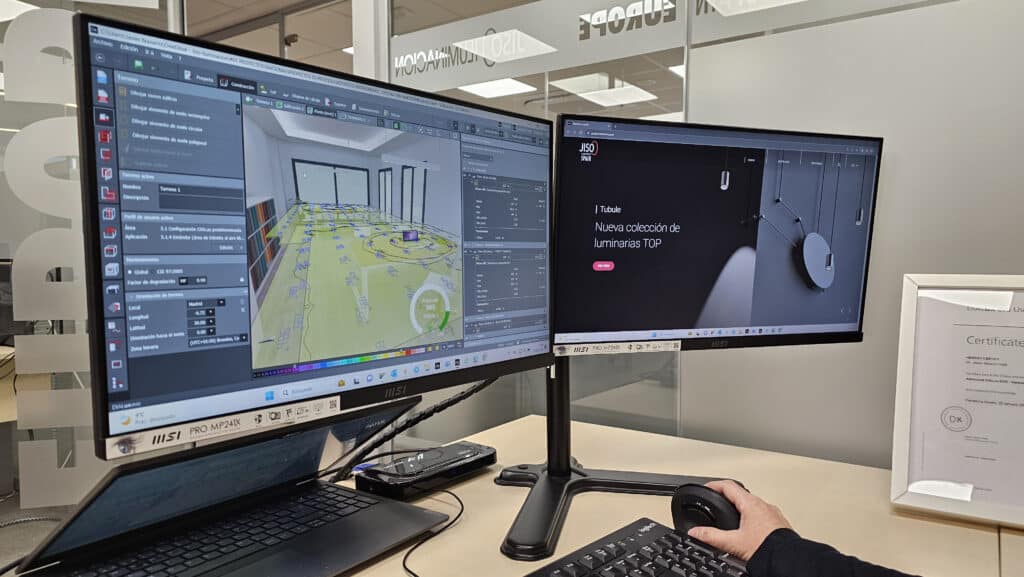We’ve covered the importance of a lighting designer,essential for successfully managing a lighting project,and explained the process of carrying out such projects. Now, let’s delve into the more tedious and less creative aspect: the regulations we need to follow in order to make our project “legal”.
The first thing to understand before exploring which regulations apply to a project is whether the project must comply with any regulations. To do this, we need to grasp the difference between required levels and recommended levels.
The debate could be lengthy because some standards don’t mandate but rather recommend. To keep things clear, let’s state that all spaces of public access or areas of pedestrian traffic, as well as certain private spaces where minimum light levels are required for safety, must comply with regulations, with some exceptions.
If your primary projects are in the residential sector, congratulations! This falls under one of the exceptions. In residences (both the interior and exterior of private individual homes), you are not obligated to adhere to minimum light levels. However, recommended values are provided, as outlined in the table below. (Note that these values are “recommended”).
RESIDENCES
Type of Area Illuminance in Service (lux)
General bedroom 50
Bedroom headboard 200
General bathroom 100
Shaving and make-up area in bathroom 500
General living space 100
Reading and sewing area 500
Stairs 100
General kitchen 300
Kitchen work area 500
Desk 300
Children’s room 100
Source: Luminotecnia 2002 – Control and Application of Light – Indalux
What regulations or recommendations should I follow for interior lighting projects?
While we can’t cover all the content of the standards in this post, we’ll provide a list of standards or recommendations that you can explore for more in-depth information. In each of them, you’ll find requirements or recommendations related to minimum illuminance levels (lux), luminance distribution, uniformity, UGR, CRI, energy efficiency, etc.
Currently in Spain, we need to take into account the following regulations for our projects:
1. Building Technical Code – CTE (HE3)
This code applies to newly constructed buildings and interventions in existing buildings, involving renovations or extensions of facilities, changes in the building’s characteristic use or alterations in activity within a building area.
2. Standard UNE-EN 12464-1:2022. Lighting of workplaces. Part 1: Indoor workplaces.
This is undoubtedly the most comprehensive standard and serves as a foundation for many professionals working on lighting projects. Although not mandatory, it is used as a reference due to the lack of standards and information for all spaces utilising artificial lighting.
3. Occupational Risk Prevention Law. ROYAL DECREE 486/1997, of 14 April, sets forth the minimum health and safety provisions in workplaces.
Under Article 8 of this law, the lighting section stipulates that “Workplace lighting must provide workers with appropriate visibility conditions to navigate and perform their activities without jeopardising their safety and health”.
What regulations or recommendations should I follow for exterior lighting projects?
Similar to the standards applicable to interior lighting projects, there are mandatory regulations and others recommending specific values or minimum requirements for outdoor installations.
1. ROYAL DECREE 1890/2008. Regulation addressing the energy efficiency of outdoor lighting installations.
This regulation took years to be approved, and unfortunately, it has become obsolete, particularly concerning light pollution—a significant environmental and public health problem. The new version of this regulation has been awaiting approval since 2019.
The purpose of this regulation is to establish the technical conditions for the design, execution and maintenance that outdoor lighting installations must meet, with the aim of:
a) Improving energy efficiency and savings, as well as reducing greenhouse gas emissions.
b) Limiting nocturnal light glare or light pollution and reducing intrusive or bothersome light.
It is not the purpose of this regulation to establish minimum values for lighting levels in different types of roads or spaces to be illuminated, which will be governed by the regulations applicable to them.
2. Autonomous laws for the protection of the night sky.
There are numerous regional or even municipal regulations that legislate on the protection of the night sky, and some of them undoubtedly represent a significant advance in safeguarding our skies.
3. UNE-EN 12464-2:2016. Lighting of workplaces. Part 2: Outdoor workplaces.
4. UNE-EN 12193:2020. Lighting of sports facilities.
Similar to the UNE standard for interior lighting, these guidelines are not mandatory but recommended, given the absence of current Spanish regulations covering all spaces with outdoor lighting installations.
Were you familiar with these standards or recommendations? In future posts, we’ll explore them further, considering that, in many cases, the standard may not be the sole determining factor when undertaking a lighting project.


